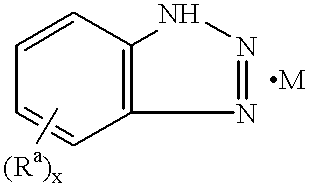Method for treating water circulating systems
a technology of water circulation system and water circulating system, which is applied in the direction of biocide, other chemical processes, applications, etc., can solve the problems of deterioration of wooden elements of the system or painted surfaces, difficult to deal with metal corrosion forms, and phenomenon called white rus
- Summary
- Abstract
- Description
- Claims
- Application Information
AI Technical Summary
Problems solved by technology
Method used
Image
Examples
example 2
Use of Composition A, Along with DTEA, To Treat Building Cooling System
The water-cooled system controls temperature in a high-rise office building and includes an evaporator, a chiller, and similar heat-rejection equipment. The piping in the system was seriously fouled with white rust and biofilm. A stream of make-up water is needed to maintain the water level in the main body of water in the system. The system also has piping for the main body of water. A 1.5% aqueous solution (specific gravity 1.02) of decyl thioethyl ether amine (DTEA) was continuously pumped into the main body of water at the rate of 25 lb / 1,000 gal. of water / wk. After the DTEA was being introduced, and for the next ten cycles of recirculation through the system, Composition A was introduced in doses of 600 ppm per cycle. After one week of treatment, the white rust layer in the system began to decrease in thickness.
PUM
| Property | Measurement | Unit |
|---|---|---|
| pH | aaaaa | aaaaa |
| metallic | aaaaa | aaaaa |
| corrosion chemistry | aaaaa | aaaaa |
Abstract
Description
Claims
Application Information
 Login to View More
Login to View More - R&D
- Intellectual Property
- Life Sciences
- Materials
- Tech Scout
- Unparalleled Data Quality
- Higher Quality Content
- 60% Fewer Hallucinations
Browse by: Latest US Patents, China's latest patents, Technical Efficacy Thesaurus, Application Domain, Technology Topic, Popular Technical Reports.
© 2025 PatSnap. All rights reserved.Legal|Privacy policy|Modern Slavery Act Transparency Statement|Sitemap|About US| Contact US: help@patsnap.com



